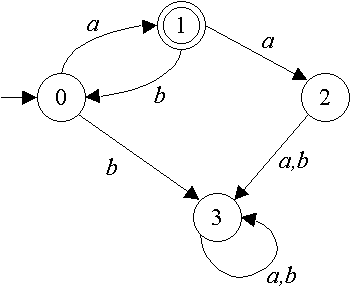
CS403 - Computational Complexity Theory
Class Test 1
Friday 15 November 2002, 15:00, SLT

CS403 - Computational Complexity Theory
Class Test 1
Friday 15 November 2002, 15:00, SLT
T Naughton, CS NUIM,
Back to CS403 home
Remove everything from your desk except pens/pencils. Paper will be provided. Answer all questions. Remember to be mathematically precise in all of your answers. You have until 15:50. You can leave whenever you are finished.
Note: Finite automata are deterministic by default.
Q1 Construct the state diagram for a finite automaton that accepts the language L = {w : wÎ{a,b}*, w is empty or contains the substring aab}. [2 marks]
Q2(a) Construct the state diagram for the finite automaton M written formally as M = (Q, S, d, q0, F) = ({0, 1, 2, 3}, {a, b}, d, 0, {2, 3}) where d is
Q\S| a b
---------
0 | 0 1
1 | 2 1
2 | 3 2
3 | 2 3
[2 marks]
Q2(b) What language does the machine in Q2(a) accept? [1 mark]
Q2(c) If we change F to be F={1, 2} in the machine in Q2(a), what are the first 6 words in the lexicographical ordering of the new language accepted by the machine? [1 mark]
Q3 Describe with an English sentence the language accepted by the finite automaton M = (Q, S, d, q0, F) = ({00, 01, 99}, {0, 1}, d, 00, {00}) where d is
Q\S | 0 1
-----------
00 | 01 00
01 | 99 01
99 | 99 99
[2 marks]
Q4 The state diagram of finite automaton M is given below. Describe with an English sentence the language accepted by M.
 [2 marks]
[2 marks]
Q5 Let finite automaton M be written formally as M = (Q, S, d, q0, F) = ({00, 01, 99}, {a, b}, {((00, a), 01), ((00, b), 99), ((01, a), 01), ((01, b), 00), ((99, a), 99), ((99, b), 00)}, 00, {99}). Construct a table of behaviour of a Turing machine within which the transition function d of M is embedded. State clearly the starting state and accepting states of the resulting Turing machine. [2 marks]